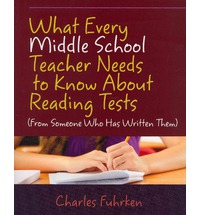Inside Scoop on Reading Tests
What Every Middle School Teacher Needs to Know About Reading Tests (From Someone Who Has Written Them)
by Charles Fuhrken
(Stenhouse Publishers, 2012 – Learn more)
Frustrated with the lack of information from my state testing agency, and after trying several other books promising to help me prepare my students for my state’s achievement exam, I went searching for a way to give my students all the tools they would need to succeed on these tests.
I was sick of test prep that required my students to read boring chunks of texts with accompanying worksheets and endless repetition — tired of “strategies” that killed their desire to read and left them feeling defeated during testing time because they didn’t know what the questions were asking and how to go about answering them.
Then I found Charles Fuhrken’s book.
Teacher-friendly and ready to apply

Fuhrken, who has considerable teaching experience in addition to his work as a reading and writing test specialist, knows how to communicate with his audience. Written in clear and concise prose without any education-ese, this book was an uncomplicated read, organized in a teacher-friendly format and ready to apply immediately.
Finally I found a book that not only describes a problem that teachers encounter in the classroom, but also explains how to solve it. With Fuhrken’s help, I can now give my students strategies they can remember and use when it’s time to take reading tests, and best of all, I can do that using rich and engaging activities that integrate well into the content I teach.
Inside the book
The book is broken into four sections: Building Understanding about Tests, Exploring Strategies for Reading Tests, Putting Strategies to Work, and Demonstrate Understandings with Reading Activities. From the first section I gained a personal understanding of how reading tests are written — things I never knew. Section One is also filled with ideas to teach students the vocabulary of tests and the different skills of test taking to build their confidence in their ability to be successful test-takers from the get-go.
Section Two focused on the 30 most commonly assessed standards, grouped into six chapters by type, such as vocabulary development and literary elements. What I appreciated most about Section Two was the listing of various words and alternate versions of question-wording that might be used for the same type of test question. (For example: theme, lesson, moral, what the character learns, the author’s main purpose.)
Ever since I had a student come back after a test telling me that I never taught them about “descriptors” (of course I did, but we called them adjectives!) I have been mindful of the difference between the vocabulary of the classroom and our standards documents, and the phrasing that may show up on the tests.
A bit too much detail?
The chapters in Section Two follow the same basic format, with an introduction to the type of assessment question followed by some basic strategies to teach students. Each chapter concludes with specific example questions and a comprehensive analysis of how a test-taker should approach each example — what might throw students off, and what strategies can help them discern the correct answer.
I found the first few pages of each chapter to be most helpful, supplying generalized information that applied to most questions students would encounter and which I could easily integrate into my instruction. I was personally more interested in overall strategies than ones specified for a certain question, and I found reading two or three pages that deconstructed each question a bit tedious. The book was certainly thorough, but this part dragged for me.
Much of the information on how to get students to see the correct answer employed strategies like substitution and going back to the text — strategies most teachers use already. I didn’t need the explanation there. I did, however, appreciate the ideas for visualization, the strategy to “chunk and jot down,” and the idea of teaching “anchor examples.”
Plenty of practical advice
A full third of the book (Sections Three and Four) is devoted to practical classroom application! This is what I hope for in all my education reading — not just theory and advice but solutions that are realistic for the regular classroom.
Section Three takes the form of practice “tests” with side notes on how to go about answering the questions for use in mini-lessons or think-alouds. Section Four gives clearly subdivided activities that easily fit into existing lessons and enhance student learning of text while being a part of test preparation. All the handouts needed are explained and included in the appendices. Each activity is really more a mini-lesson or extension of what you are already teaching and includes resources, procedure, assessment, and sometimes extension and student examples.
Other books have given me ways to integrate their ideas into my lessons, but the lessons here focus on the same content I would be teaching anyway — but with small tweaks that allow more focus on particular skills. Some activities are ones I already use, in fact, such as found poems, but are shown in a new way with new application. The best part is that students might actually enjoy the activities while they learn, which I can’t say about the test prep I’ve done in the past.
The approach given in What Every Middle School Teacher Needs to Know About Reading Tests is exactly what I have been looking for and this is one book that will most definitely not be sitting on the back shelf gathering dust.
Rebecca Crockett teaches language arts and reading to seventh and eighth graders and enjoys blending technology and media literacy into her lessons as well as working with other teachers across content areas. She lives in north central Idaho with her husband and two young children. She is an avid reader and sometimes writer for her own enjoyment and to practice what she preaches.





































How does this book correlate with Common Core?